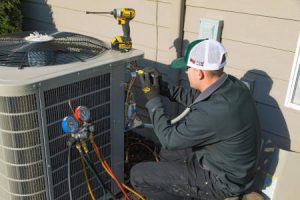What Is SEER?
In a nutshell, SEER is a tool used to compare different makes and models of Air Conditioner units. It breaks down how much energy an AC unit uses into one simple number every manufacturer uses so that you have a quick way to see how each performs.
What Does SEER Mean?
If you want the technical definition of SEER, let’s get into that with some context.
SEER is an acronym for Seasonal Energy Efficiency Ratio. The ratio is found by dividing the typical cooling output by the typical energy used during the same season. So it can look like the average amount of cooling your AC provided during summer divided by the average amount of energy your AC used. This then gets rounded to a whole number.
This ratio is a standardized equation that can be done only one way by any AC manufacturer. That means that two different manufacturers can’t come up with a different rating for the same AC hardware just because they took creative liberties with the calculation.

Is SEER Accurate?
SEER is how AC manufacturers categorize their units by efficiency. As we described earlier, the SEER rating tells you how much energy an AC unit uses to generate cooling. Since it’s a standardized equation, it makes for an accurate
method of comparing one AC unit to another. However, it may not tell the full picture of what
your own experience will look like.
SEER is a maximum efficiency calculation. That means it will tell you how efficient an AC unit is under optimal conditions with an optimal setup. An AC unit could lose efficiency based on the HVAC system it is installed into and the way it is installed. A unit that is oversized or undersized will run inefficiently and provide uneven or inconsistent cooling. That’s why it’s also important to purchase an AC unit by size and not just by rating.

How To Find The Right SEER
An HVAC sales professional can complete a load calculation to determine what size AC your home needs. That information can then be paired with the SEER rating to get an accurate idea of what AC unit would be most efficient for your home.
How Much Does Installation Affect SEER?

Installation affects SEER quite a bit. As we mentioned earlier, SEER is about maximum efficiency. You will notice a difference in lifetime cost based on how the installing contract views system performance.
Function-Based
If the company handling the installation is function-based, they will get your AC unit installed and running, but you might run into the issue of the unit being over or undersized. There may be additional problems with the HVAC system that affect performance that they just won’t be looking for. If the furnace is going bad or if the ductwork doesn’t have enough clearance, a high SEER AC won’t solve any problems for you.
Performance-Based
If the company performing the installation is performance-based, then they will spend more time thinking about the HVAC system and how it integrates into your home. They will make sure that the AC is the right size for your home. The sales professional from that company will also make sure that the HVAC system will utilize the AC unit’s maximum efficiency to make that high SEER rating worth it.
All in all, the difference between companies could be around 30% of that AC unit’s operating cost. That’s not to mention the cost of repair or replacement should an AC unit break down from straining to keep up with the required cooling load, or freeze over from poor airflow.
How Does SEER Affect Me?
As we discussed in the last section, SEER determines how energy efficient an AC unit is. To break it down in simplest terms, the SEER rating of an AC unit affects how much money you spend and cool your home stays. These are going to be the two ways you primarily feel the difference in SEER ratings.
Money Invested
This could be money spent in the long-term or money spent as a lump sum on the installation.
A system with a high SEER rating is going to save you money on the energy used to provide cooling to your home. Naturally, a more efficient machine is going to cost more upfront, but it can prove to be an investment that pays for itself in long-term savings.
A system with a low SEER rating will be less expensive to purchase and install. Keep in mind, that a less efficient system will use more energy. Over their lifetime, a low SEER unit could cost you more in total expenses than a more efficient unit.

Cooling Performance
A high SEER AC unit that is the right size for your home is also going to be time-efficient when it comes to cooling. These more efficient systems are often designed to run at a range of speeds and do more to maintain a consistent temperature.
That means that your AC can make slight adjustments in temperature using low power when the weather is mild. As the weather gets more extreme, the AC unit will scale to compensate. This means the temperature throughout your home is going to be more even.
The steady and even airflow will also work to keep humidity low inside your home. A high SEER AC can then be paired with zoning to further control the climate inside your home.
Downsides of Low SEER
Low SEER ACs are typically single-stage and run only at one speed. That means they are on or off. Running at one speed means that it will go on at full blast the second that your thermostat detects the ambient temperature goes up. That’s like using a car wash to dampen a washcloth.
This leads to uneven temperatures throughout your home, as the system will send the coldest air possible to the entire home until it detects a change back at the thermostat.

The inefficient airflow can also result in high humidity. That will make the interior of your home seem warmer than it actually is and can also cause mildew problems
What Is A Good SEER?
The modern standard for SEER ratings is 13. Most AC units on the market today have a SEER rating ranging between 13 and 22. Any of the units that have a rating above 20 are considered to be exceptionally good. Depending on where you live, you may not be able to buy an AC lower than 13 or 14. That’s not to say that lower SEER systems aren’t out in the wild. If you have an older home that hasn’t had the AC replaced, the unit may be as low as SEER 8 or 9.
The reason you can’t find a new AC with a low SEER is that there is actually a minimum performance standard regulated by the Department of Energy. The standard in the North is 13. In the southeast, the standard is 14 for split-system ACs. In the southwest, the standard is 14. If you want more information on how the Department of Energy manages SEER ratings, you can read that here. That standard is set to change in 2023 to increase the minimum efficiency that can be found on the market.
If you just want a quick way to see where an AC unit falls on the scale, look for an Energy Star Certification. To qualify for Energy Star, a unit must have a SEER rating of at least 14.
The Bottom Line on SEER
SEER is that ratio that shows how energy efficient an AC unit is. A higher rating means a unit is more efficient. This determines how much money you will spend on energy and how well it will cool your home. Standard SEER ratings go from 13 to 22, and some exceptional units go above that. Standard SEER ratings on the market are set to increase based on new guidance from the Department of Energy.

Who Are Advantage Heating and Air Conditioning, LLC?
We are your local HVAC Experts out of Salem, Oregon. We hope that gave you the information you need to be an educated shopper when it comes to your Air Conditioner. If you have other questions about HVAC systems, check out our other blogs. To learn more about who we are and how we can help you, visit our website and follow us on social media – we’re here when you need us!







